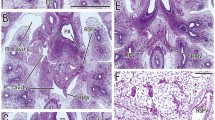Summary
The configuration of the upper myocardial border, considered by us to represent the arterial orifice level, has been studied microscopically and with the help of reconstruction techniques, in 7 human embryos ranging from 6 to 9.5 mm crown-rump length. In the 6 to 7 mm stage the arterial orifice level is not situated in one plane but has a curved configuration and reaches up to the origin of the 4th and 6th branchial arch arteries. As a consequence the septation, by the aortopulmonary septum, starts at orifice level. In the 9 to 9.5 mm stage the arterial orifice level has not only a curved but also a “twisted” configuration. This implies that 1) the pulmonary trunk is very short whereas the ascending aorta is rather long, 2) the pulmonary outlet is rather long whereas the aortic outlet is very short, and 3) the position of the aortopulmonary septum is such that it extends a long way proximal in the pulmonary outlet but hardly any distance in the aortic outlet. This means that the position of the orfices as well as the relative dimensions of both outlets are already similar to those in the fully developed heart.
Similar content being viewed by others
References
Anderson RH, Becker AE, Tynan M (1986) Description of ventricular septal defects or how long is a piece of string. Int J Cardiol 13:267–278
Bartelings MM, Wenink ACG, Gittenberger-de Groot AC, Oppenheimer-Dekker A (1986) Contribution of the aortopulmonary septum to the muscular outlet septum in the human heart. Acta Morphol Neerl-Scand 24(3):181–192
Born G (1883) Die Plattenmodelliermethode. Arch Mikrosc Anat 22:584–599
Congdon ED (1922) Transformation of the aortic-arch system during development of the human embryo. Contrib Embryol Carnegie Ins Washington 14:47–110
Laane H-M, Roest-Wagenaar JA (1981) Development and Fusion of Endocardial Structures in the arterial pole of the heart of chick, rat and human embryos. In: Pexieder T (ed) Mechanisms of Cardiac Morphogenesis and Teratogenesis, Perspectives of Cardiovascular Research 5:267–277 Raven Press, New York
Los JA (1978) Cardiac septation and the development of the aorta, pulmonary trunk and pulmonary veins. In: Rosenquist GC, Bergsma D (eds) Morphogenesis and malformation of the cardiovascular system, Birth Defects, Original Article Series, XIV-7: 109–138. Alan R Liss Inc, New York
Maron BJ, Hutchins GM (1974) The development of the semilunar valves in the human heart. Am J Pathol 74:331–334
McBride RE, Moore GW, Hutchins GM (1981) Development of the outflow tract and closure of the interventricular septum in the normal heart. Am J Anat 160:309–331
Orts-Llorca F, Puerta-Fonolla J, Sobrado J (1982) The formation, septation and fate of the truncus arteriosus in man. J Anat 31:41–56
Pexieder T (1978) Development of the outflow tract. In: Rosenquist GC, Bergsma D (eds) Morphogenesis and malformation of the cardiovascular system, Birth Defects, Original Article Series, XIV-7:29–68. Alan R Liss Inc, New York
Pexieder T, Janacek P (1984) Organogenesis of the human embryonic and early fetal heart as studied by microdissection and SEM. In: Nora JJ, Takao A (eds) Congenital Heart Disease: Causes and Processes 401–421. Futura Publ Co, Mount Kisco, New York
Roest-Wagenaar JA (1975) An electronmicroscopic study of the truncus ridges in chick embryos. Acta Morphol Neerl-Scand 13:187–200
Sissman NJ (1970) On embryologic terminology and the truncus arteriosus. In: Jaffee OC (ed) Cardiac Development with special reference to congenital heart disease. Proceedings of the 1968 international symposium: 11–27, University of Dayton Press, Dayton, Ohio
Tinkelenberg J (1979) Graphic reconstruction, micro-anatomy with a pencil. J Audiov Media Med 2:102–106
Thompson RP, Fitzharris TP (1979) Morphogenesis of the truncus arteriosus in the chick embryo heart: Tissue reorganization during septation. Am J Anat 156:251–264
Thompson RP, Wong Y-M, Fitzharris TP (1983) A computer graphic study of truncal septation. Anat Rec 206:207–214
Thompson RP, Sumida H, Abercrombie V, Satow Y, Fitzharris TP, Okamoto N (1985) Morphogenesis of human cardiac outflow. Anat Rec 213:578–586
Wenink ACG, Gittenberger-de Groot AC, Oppenheimer-Dekker A, Van Gils FAW, Bartelings MM, Draulans-Noë HAY, Moene RJ (1984) Septation and valve formation: similar processes dictated by segmentation. In: Nora JJ, Takao A (eds) Congenital Heart Disease: Causes and Processes 513–529 Futura Publ Co, Mount Kisco, New York
Wenink ACG, Gittenberger-de Groot AC (1985) The role of the atrioventricular endocardial cushions in the septation of the heart. Int J Cardiol 8:25–44
Author information
Authors and Affiliations
Rights and permissions
About this article
Cite this article
Bartelings, M.M., Gittenberger-de Groot, A.C. The arterial orifice level in the early human embryo. Anat Embryol 177, 537–542 (1988). https://doi.org/10.1007/BF00305140
Accepted:
Issue Date:
DOI: https://doi.org/10.1007/BF00305140




